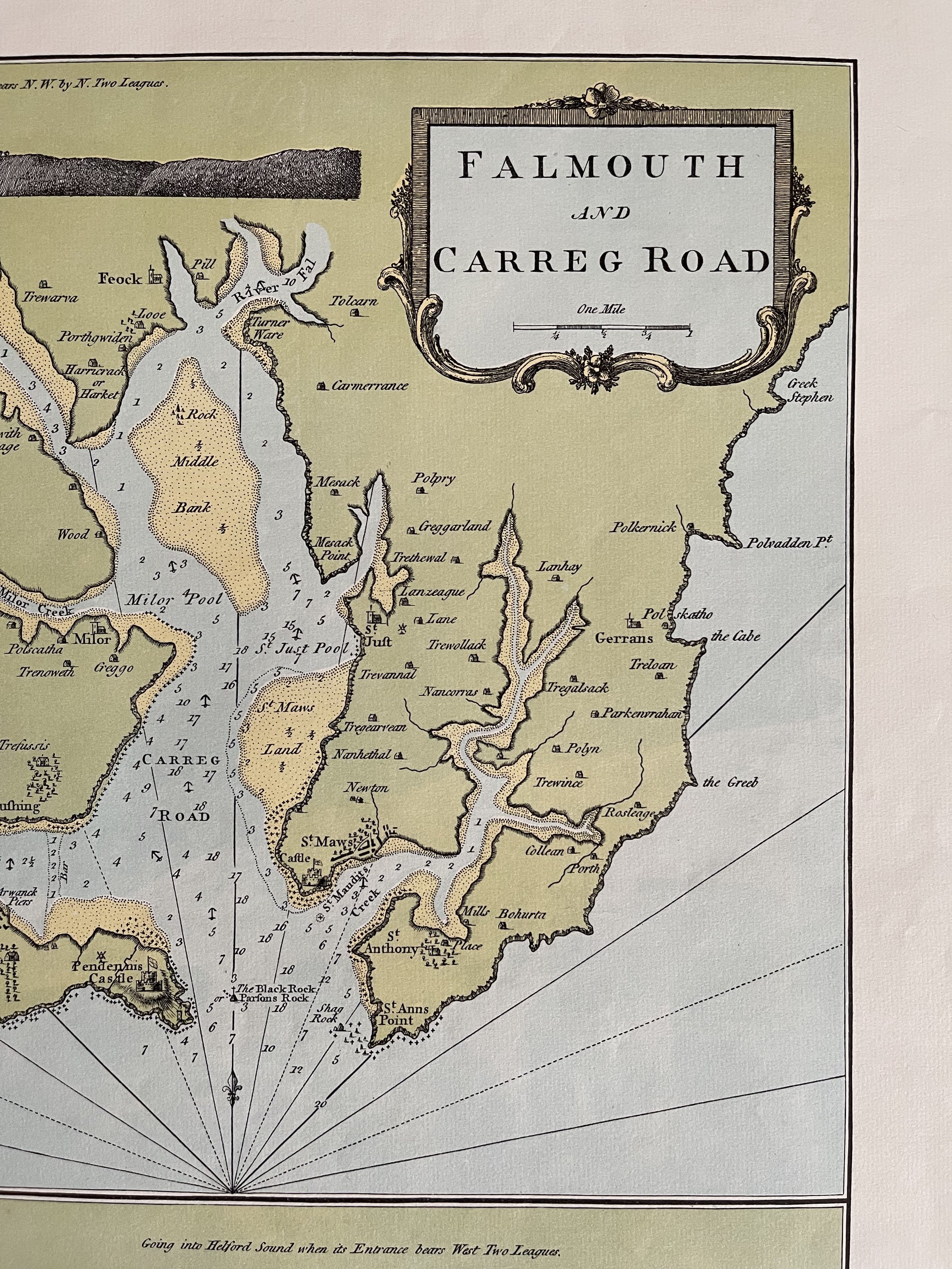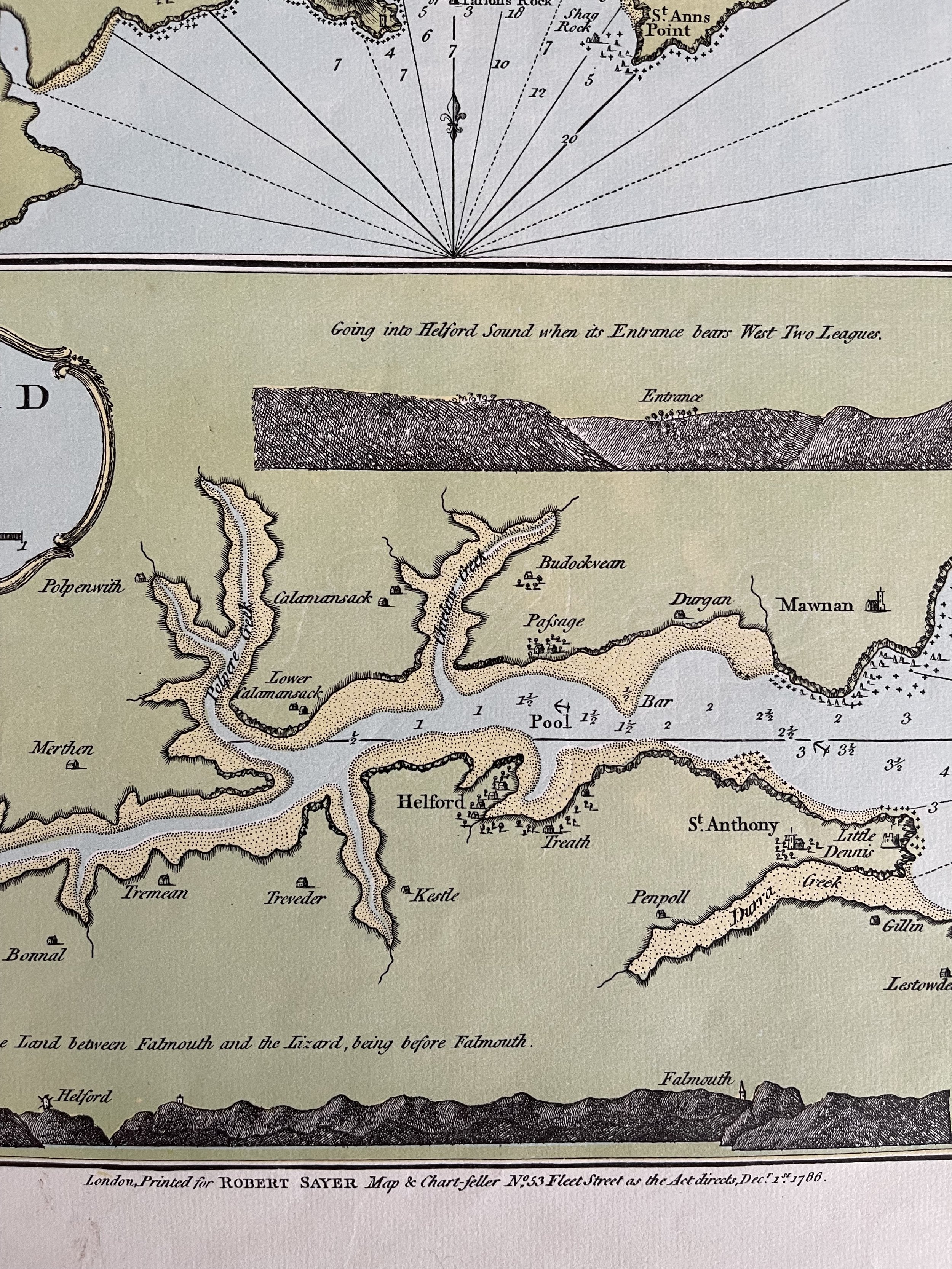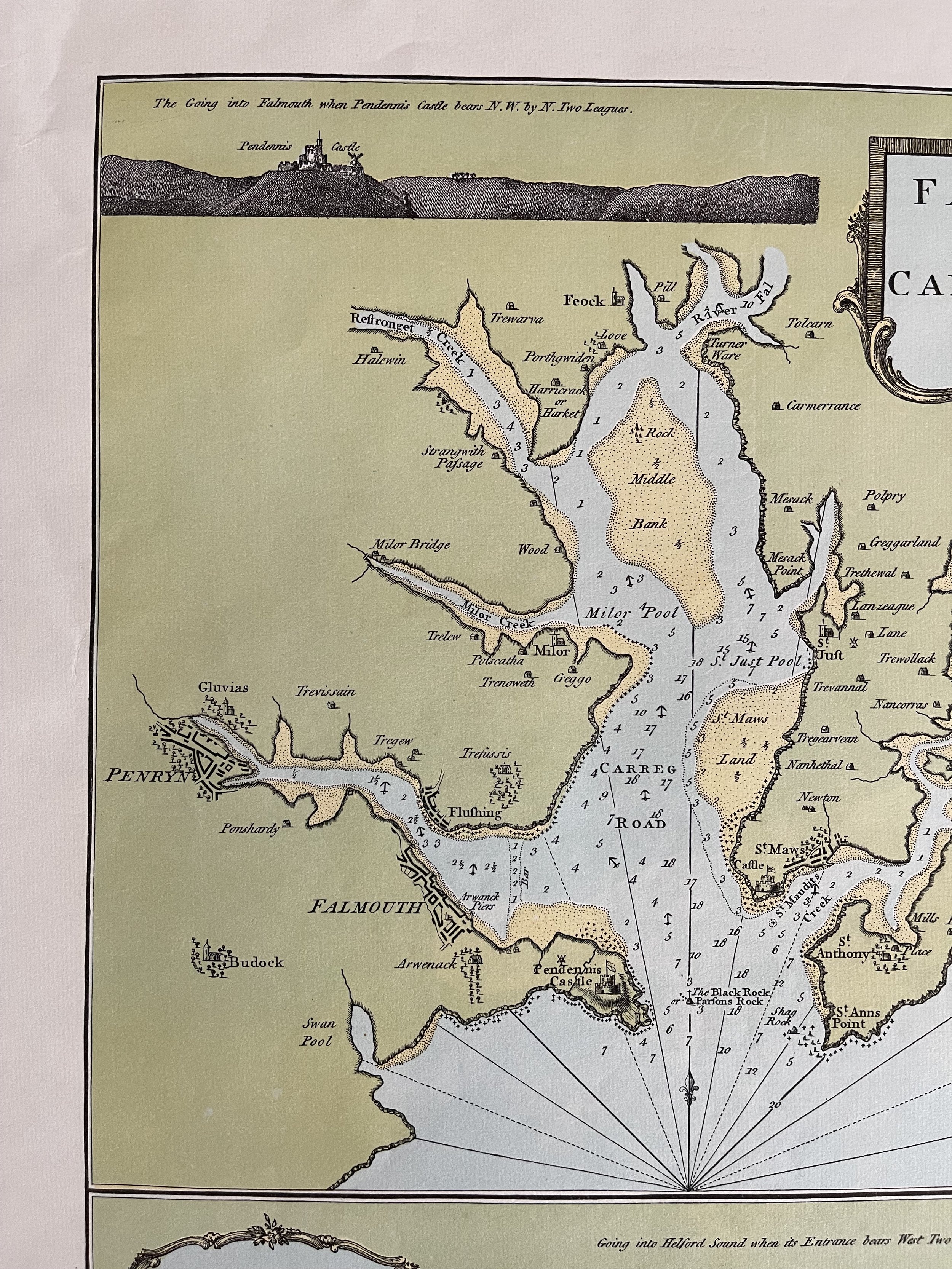Falmouth and Carreg Road, England - Robert Sayer - 1970
This chart is bound in Sayer & Bennett's A Complete Channel Pilot, comprehending the English and French coasts, from the Thames Mouth to the Bay of Biscay, including the North Sea, with sailing directions. Copperplate engraving. Two plans on one sheet. Vintage copy as the original dates from 1779.
Vintage Copy on modern laid paper with water mark. Circa 1970
Robert Sayer (1725–1794) was a leading publisher and seller of prints, maps and maritime charts in Georgian Britain. Born in Sunderland England in 1725. He was based near the Golden Buck on 53 Fleet Street in London.
Sayer's brother James married the widowed Mary Overton, daughter-in-law of John Overton the printseller. Sayer became her assistant, being called manager of the Golden Buck by 1748, and in this way gradually took over the existing Overton business as a going concern.
John Bennett, who began as a servant to Sayer in 1760, and later an apprentice (1765) and a free journeyman (1774), eventually partnered with Sayer with one-third share in the Fleet Street business. The business traded as Sayer & Bennett. In 1781, Bennett was admitted to Dr Thomas Monro's Brook House asylum in Clapton. Sayer would seek to dissolve the partnership in 1785 based on Bennett's mental condition. Bennett later died in 1787. Upon the partnership dissolution, the business was renamed Sayer & Co. or Robert Sayer & Co., probably a reference to his assistants Robert Laurie and James Whittle.
Sayer published atlases and other cartographic works, publishing the Mundane System (1774) of Samuel Dunn and the famous North American Pilot (1775), which included important charts made by the great circumnavigator and explorer Captain James Cook.
Sayer also had an "almost complete set of copies" of painter William Hograth's plates and sold prints at prices that undercut those of Hogarth's widow and printseller, Jane Hogarth.
This chart is bound in Sayer & Bennett's A Complete Channel Pilot, comprehending the English and French coasts, from the Thames Mouth to the Bay of Biscay, including the North Sea, with sailing directions. Copperplate engraving. Two plans on one sheet. Vintage copy as the original dates from 1779.
Vintage Copy on modern laid paper with water mark. Circa 1970
Robert Sayer (1725–1794) was a leading publisher and seller of prints, maps and maritime charts in Georgian Britain. Born in Sunderland England in 1725. He was based near the Golden Buck on 53 Fleet Street in London.
Sayer's brother James married the widowed Mary Overton, daughter-in-law of John Overton the printseller. Sayer became her assistant, being called manager of the Golden Buck by 1748, and in this way gradually took over the existing Overton business as a going concern.
John Bennett, who began as a servant to Sayer in 1760, and later an apprentice (1765) and a free journeyman (1774), eventually partnered with Sayer with one-third share in the Fleet Street business. The business traded as Sayer & Bennett. In 1781, Bennett was admitted to Dr Thomas Monro's Brook House asylum in Clapton. Sayer would seek to dissolve the partnership in 1785 based on Bennett's mental condition. Bennett later died in 1787. Upon the partnership dissolution, the business was renamed Sayer & Co. or Robert Sayer & Co., probably a reference to his assistants Robert Laurie and James Whittle.
Sayer published atlases and other cartographic works, publishing the Mundane System (1774) of Samuel Dunn and the famous North American Pilot (1775), which included important charts made by the great circumnavigator and explorer Captain James Cook.
Sayer also had an "almost complete set of copies" of painter William Hograth's plates and sold prints at prices that undercut those of Hogarth's widow and printseller, Jane Hogarth.
This chart is bound in Sayer & Bennett's A Complete Channel Pilot, comprehending the English and French coasts, from the Thames Mouth to the Bay of Biscay, including the North Sea, with sailing directions. Copperplate engraving. Two plans on one sheet. Vintage copy as the original dates from 1779.
Vintage Copy on modern laid paper with water mark. Circa 1970
Robert Sayer (1725–1794) was a leading publisher and seller of prints, maps and maritime charts in Georgian Britain. Born in Sunderland England in 1725. He was based near the Golden Buck on 53 Fleet Street in London.
Sayer's brother James married the widowed Mary Overton, daughter-in-law of John Overton the printseller. Sayer became her assistant, being called manager of the Golden Buck by 1748, and in this way gradually took over the existing Overton business as a going concern.
John Bennett, who began as a servant to Sayer in 1760, and later an apprentice (1765) and a free journeyman (1774), eventually partnered with Sayer with one-third share in the Fleet Street business. The business traded as Sayer & Bennett. In 1781, Bennett was admitted to Dr Thomas Monro's Brook House asylum in Clapton. Sayer would seek to dissolve the partnership in 1785 based on Bennett's mental condition. Bennett later died in 1787. Upon the partnership dissolution, the business was renamed Sayer & Co. or Robert Sayer & Co., probably a reference to his assistants Robert Laurie and James Whittle.
Sayer published atlases and other cartographic works, publishing the Mundane System (1774) of Samuel Dunn and the famous North American Pilot (1775), which included important charts made by the great circumnavigator and explorer Captain James Cook.
Sayer also had an "almost complete set of copies" of painter William Hograth's plates and sold prints at prices that undercut those of Hogarth's widow and printseller, Jane Hogarth.
Code : A109
Cartographer : Cartographer / Engraver / Publisher: Robert Sayer - Vintage Copy
Date : Publication Place / Date - 1970 approx
Size : Sheet size: Image Size: 64.5 X 44 cm
Availability : Available
Type - Genuine - Vintage
Grading A-
Where Applicable - Folds as issued. Light box photo shows the folio leaf centre margin hinge ‘glue’, this is not visible otherwise.
Tracked postage, in casement. Please contact me for postal quotation outside of the UK.





